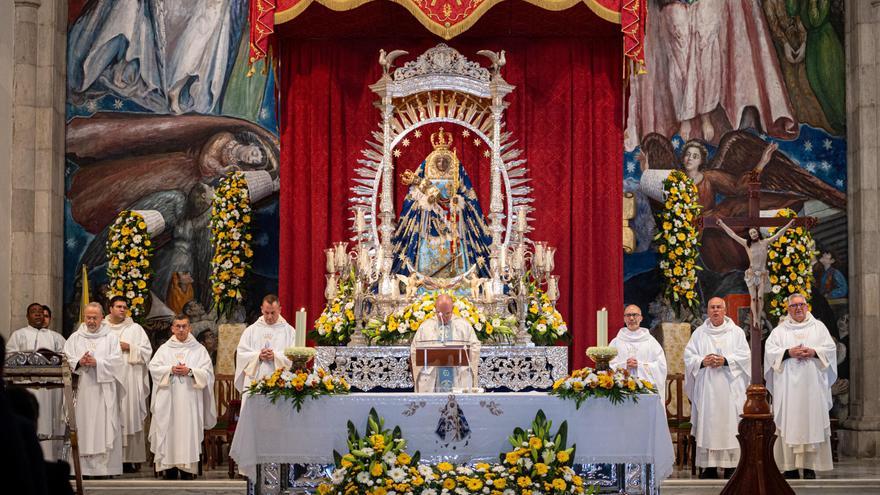
Solidarity and compassion towards migrants. This was the appeal made by the diocesan administrator Antonio Manuel Pérez Morales during the festivities for Candelaria Day. He is currently overseeing the Nivariense diocese as they await the appointment of a new bishop. This was the principal message conveyed during the homily delivered on February 2 at the Basilica of Candelaria, where he reflected that, “as the waters that brought the image of the Virgin centuries ago, today men, women and children arrive with hearts overflowing with hope and need.”
Despite the influx of hundreds of pilgrims to the Villa Mariana in the early hours of Sunday, strong winds marred the celebrations, hindering, for the second consecutive day, the procession of the Virgin’s image through the square. Consequently, the attendees from Tenerife had to enter the basilica before and after the Mass to pay their respects to the patron of the Canary Islands, who was also visited by numerous dignitaries from both Tenerife and across the archipelago. Additionally, although the Musical Artistic Group (AAM) La Candelaria de Arafo had a performance scheduled, it was forced to cancel due to the procession’s cancellation. This occasion was particularly significant as the group begins the programme Way to 100, marking their centenary, with their inaugural performance outside Arafo held at Candelaria during this festival.
Shortly after 11:30 am on Sunday, the civic procession transferring the Pendon of the Villa commenced towards the Basilica of Candelaria, where, following a bell ringing just after midday, the Eucharist began. After 19 years presided over by Bishop Bernardo Álvarez, this was the first Candelaria Day Mass in which he was absent, with the Eucharist led by the Diocesan administrator, Antonio Pérez. The musical aspect was provided by the Orfeón La Paz de la Laguna.
As with the preceding day, the Virgin was adorned with a brocked blue mantle of natural silk crafted in Paiporta at the José Bartual Castellets workshops, donated by a family in Puerto de la Cruz as a gesture of solidarity with the Valencian Community, which faced severe consequences from the Dana in October.
During the homily, Antonio Pérez reminded attendees that, for many, this celebration signifies the conclusion of the Christmas festivities. He emphasised that the Virgin of Candelaria “is not merely a cherished image for our community but resides in the very essence of our Canarian faith.” He took the opportunity to address the ongoing migration crisis affecting the Canary Islands, a matter of repeated concern for Pope Francis. “This same sea that brought us the Virgin is now the setting for a humanitarian crisis that we cannot overlook,” he stated, referring to the so-called Atlantic route. He added that “many migrants reach these shores in search of the light of a brighter future, risking their lives, and we cannot stand idly by in the face of this challenge.” At this juncture, he echoed the words of Pope Francis, remarking: “We are all called to welcome, protect, promote, and integrate individuals who leave their homeland to save their lives or pursue a dignified future.” Antonio Pérez also noted that in October an eagerly awaited event will occur, as the pilgrimage of the Virgin of Candelaria will take place in Santa Cruz de Tenerife.
Friendship and Family
Throughout the day, many individuals from Tenerife visited the Basilica of the patron of the Canary Islands. Some locals walked from their residences, while others arrived by car; however, many chose to walk from various parts of Tenerife. María del Carmen Hernández and Lucía Herrera walked from Santa Cruz de Tenerife. They have made it a tradition to meet each year, not only for this celebration but throughout the months. “It’s like a family custom for us,” explained the women who set off at seven in the morning from the Ofra neighbourhood. “We aim to do this every fortnight, and then we take the opportunity to have breakfast and chat for a while,” they shared before entering the basilica.
Pilar Betancourt and Marlene Huamaní also regularly walk to see the Virgin of Candelaria, although they make the journey from Radazul, typically taking around two hours. They trek every Sunday as “this is a place where you feel truly at home, and we enjoy making it our destination,” explained the women, who observed that this time they encountered more people than usual, although nothing compared to the crowds that assemble on August 15.
José Daniel Lorenzo and his family arrived on foot from La Orotava, fulfilling a promise made by the family’s grandfather, José The foal, who recently passed away and could not uphold this tradition. “We have faith in the Virgin of Candelaria, and that’s why we wanted La Orotava, where we intended to recharge with a hearty lunch.
José Martín and Yurema García travelled from The victory and mentioned that they visit Candelaria approximately four or five times a year. “This is the first walk we have undertaken this year,” said the couple, who took five hours to arrive from home. “We cannot accept that months go by without visiting the Virgin, as we usually pray a lot for her intercession, and we must come to see her,” they articulated amidst the crowd in the square Patron of the Canary Islands.
















